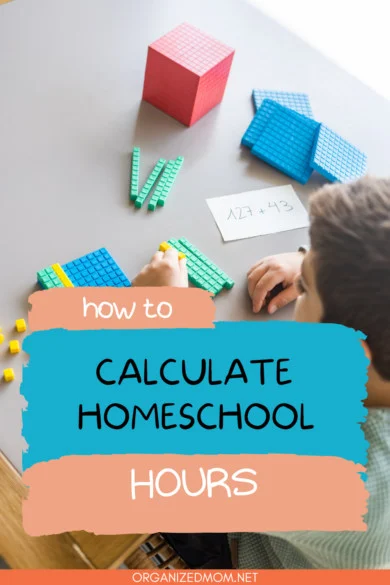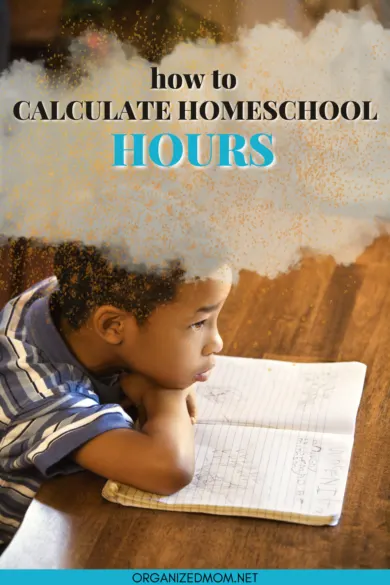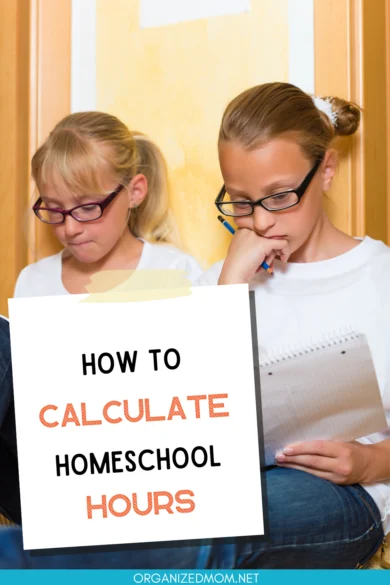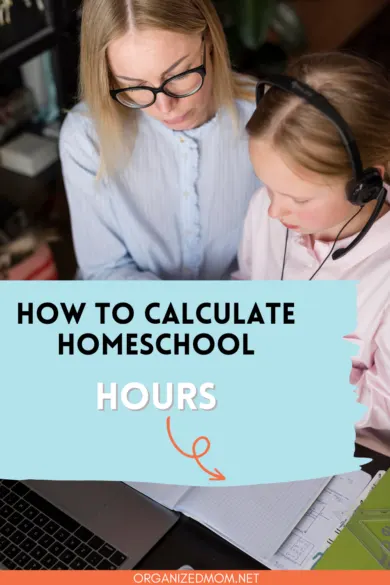The practice of homeschooling children has been around for a long time. Suppose you’re one such parent who has considered the benefits of homeschooling and would like to pursue it. Then it is worth researching how to calculate the homeschool hours your child or children will be required to learn.
Calculating homeschool hours is challenging because every child is different. Calculations should account for their learning pace, age, attention span, and interests. The hard truth is that many U.S states have taken the guessing out of it and require a set number of homeschooling hours by law.
Various sources address the topic of homeschool hours, suggesting anything from one to six hours per day. It would help if you distinguished between what is presented as recommendations and which are mandatory.
Homeschool Hours Vs. Traditional School Hours
Many parents just starting to homeschool their kids wrongly assume that their academic hours at home should match that of a traditional school.
A typical school day, in a private or public school, is roughly from 8 am until 3 pm – shorter for younger children. The school day thus amounts to anything from five to eight hours in total if you include after-school activities.
Homeschoolers can get away with learning for about half of that time.
It is vital to remember that a traditional school schedule needs to make time for the following activities that are not required by homeschooling setups:
- School teachers must do roll calls.
- Students need bathroom breaks and lunchtime.
- There are constantly things happening in class that disrupt teaching and learning, whether a simple hand is raised or something more serious, like a fight between students.
- Other disruptions are things like emergency drills and assemblies.
- Teachers must keep 20 or more students organized, engaged, and on task.
- Teachers must also collect and review homework for all the students.
- Time needs to be allocated for state testing.
These are just a few of the elements of a regular school day that does not apply to homeschooling.
Because homeschoolers are typically taught one-to-one, they often get through a study program twice as fast as their peers in a public school. The homeschool day can thus be much shorter than their counterparts, yet still, get the same amount of teaching and learning done.
Depending on the age of the homeschooled student, you can easily compress a ‘school day’ into 1-4 hours. At a traditional school, you would aim for about four hours per day of classroom activities and up to two hours per day of outdoor or physical-based play. You can produce the same output at home in 4 hours or less daily.
The 4-hour guideline is also supported by some U.S state education departments, like Colorado state regulations on the topic of homeschooling.
During the 2020 Covid pandemic, the Illinois State Board of Education published a document to provide educators, parents, and caregivers with information and guidelines on managing the unprecedented homeschooling period implemented that year. The paper suggests that students at home should only work on school activities for 1-4.5 hours a day.
This document has been widely referenced in many homeschooling articles since. It will also be used as the standard measure in the rest of this article.
There is no golden rule regarding homeschooling hours for your child. Every student learns differently, making applying a one size fits all approach impossible. It also depends on how many children you homeschool simultaneously, their extra mural activities, and their age.
Still, it is safe to say that there is no need for you to conform to a traditional school setup. Half the hours (or less for younger children) are perfectly suitable for homeschooling.
Homeschool Hours For Children In Pre-Kindergarten
According to the now wildly circulated Illinois State Board of Education document, children aged 4-4.5 should engage in schoolwork for 20-60 minutes.
This recommendation is based on this age group’s recommended sustained attention span of 3-5 minutes. Other sources claim the attention span of a four or 5-year-old to be between 8-12 minutes.
Regardless, young homeschoolers in the Pre-K phase should preferably not engage in learning activities for longer than 60 minutes in total per day. With breaks at regular intervals, this might stretch their school day to 1.5-2 hours.
A typical day could, for example, look like this:
- 08:00: Breakfast
- 08:30: First learning activity, for example, a cut-and-paste activity.
- 08:45: Take a break (e.g., walk in the garden, go to the loo, play with a pet, etc.)
- 09:00: Continue with the cut-and-paste activity or move on to a simple puzzle.
- 09:15: Go to the local library or read a book together at home.
- 10:00: Sing counting and alphabet songs together. You can even add some movements by letting your child dance while singing.
- 10:15: Let them have a break with a snack and a drink.
This is only an example but shows what 45 minutes of activities at home could look like, with another 15 minutes of active engagement that they might participate in at the library or while reading at home. That brings the total to 60 minutes while being done by mid-morning. A day like this takes the pressure off the parent conducting the homeschooling and allows more quality time with your child.
Homeschool Hours For Children In Kindergarten
Children in kindergarten (5 years) should engage in active schoolwork for 30-90 minutes daily. Since they are a year older than most Pre-K children, they can extend their learning by a small margin.
However, their attention span is more or less similar to Pre-K children’s, so engaging them in learning for more than 1.5 hours is not advisable.
Learning, in the context of a 5-year-old, refers to activities that develop their understanding, knowledge, or skills in a particular area. This might include activities like
- Playing games where the child needs to recognize letters of the alphabet and their sounds.
- Reading them a story and having the child guess what happens next/after the end.
- Doing activities that allow them to understand patterns and shapes.
- Using examples around the house to practice basic arithmetic (e.g., addition and subtraction).
You can also include outdoor play and interaction with other children their age into the recommended daily 30-90 minutes of learning. Building social skills is a crucial part of any Pre-K and kindergarten curricula, and the value of this aspect should not be underestimated.
Homeschool Hours For Children In Grades 1 & 2
The Illinois State Board of Education table recommends the same maximum learning time for 6-7 years old than the kindergarten phase, which is 90 minutes. However, their recommendation for the minimum time allocation is 45 minutes, which is longer than those for kindergarten.
This 45-90 minute learning guideline is one perspective. Other sources indicate that 1st and 2nd graders can engage in learning for 1-2 hours. This is where parents need to exercise more flexibility and aim for a suitable schooling period for their child.
The best way to start is finding a happy medium: Design a school day schedule for 85 minutes worth of educational activities. After a week, reflect on your child’s engagement level during this time and assess whether there is room to increase their learning time or whether you need to decrease it.
Remember that a six or seven-year-old attention span can be between 5 -18 minutes; sources vary. It is essential to notice when they are not enjoying a particular activity, get distracted easily, or seem in a ‘bad mood.’ In this case, try to give more breaks between activities or, if necessary, let go of your pre-planned schedule.
A trip will give your child a nice break from their usual learning routine. A 1-2 hour visit to the local zoo or an interactive art exhibition will add more learning time to their day. Yet, they won’t realize it since the activity is way more fun. You might also find the excursion adds more educational value than an activity they were bored with at home.
It’s about reading your child’s engagement level and adjusting their learning schedule accordingly.
Homeschool Hours For Children In Grades 3-5
Children between the ages of 8-10 should actively engage in academic activities for approximately 1-2 hours, as the Illinois State Board of Education recommends.
Nevertheless, you need to research your state’s requirements for homeschooling. For example, Pennsylvania and New York law requires 900 learning hours per year for students in grades 1-7. The state of Washington requires even more.
If your child complies with the compulsory 180-day attendance per year, they will have to be homeschooled for at least 5 hours a day.
Before you panic over the discrepancy, it is worth remembering that ‘school time’ is not strictly spent on core academic subjects or completing projects.
Like in a traditional school, homeschoolers do many activities in and around the house that contribute to their holistic development. If you are concerned about reaching a 5-hour mark, include the time your child spends on the following activities in your calculations:
- Trips to the grocery store, library, etc.
- Receiving external tutoring for art, music, or dance
- Physical training and sports matches
- Helping you prepare and cook food for the family
- Helping in the community
- Silent reading
- Spending time on educational games on their device (e.g., Duolingo)
- Watching a documentary
- Doing chores
Homeschool Hours For Children In Middle School
Referring once again to the Illinois State Board of Education’s chart, children in middle school should have a homeschooling schedule as follow:
- Lesson duration:
- Minimum: 15 minutes
- Maximum: 30 minutes
- Total learning time per day:
- Minimum: 90 minutes
- Maximum: 180 minutes
The guidelines regarding lesson time (15-30 minutes) support the recommended length of sustained attention for 11 to 13-year-old children, as echoed by other sources that estimate it to be roughly the same at 22-39 minutes.
Suppose you take the Illinois state regulations on compulsory homeschooling subjects as a framework. In that case, it means that your child should receive six lessons per day that cover the mandatory curriculum:
- Languages
- Math
- Biological and physical sciences
- Social sciences
- Fine arts
- Physical development and health.
Even if you teach a maximum of 30 minutes per subject, it only requires a homeschooler to study for 3 hours. If you add a child’s leisure activities and breaks, their whole day can easily extend to 4-5 hours.
Homeschool Hours For Children In High School
There is a lot at stake for parents and their high school children being homeschooled. Not only does the subject content become more challenging, but they are ultimately working towards getting their GED or an equivalent qualification.
The great thing about high school is that you have more flexibility in the subjects you choose to teach your child. However, it could be helpful to be in the know concerning what traditional school students typically focus on, for example
- Advanced math, such as calculus, trigonometry or statistics
- 18th – 20th century American literature
- United States government and economics
- Biology, chemistry, and physics.
- Various electives (e.g., foreign languages, career studies, technology, etc.)
Additional skills your homeschooler will need to develop include writing skills, citing and referencing, critical thinking, etc. These are just a few valuable soft skills you should include in your planning when calculating your child’s homeschool hours.
As we’ve seen throughout this article, the compulsory homeschooling hours differ from state to state. It is imperative to research your local state regulations on homeschooling and keep detailed records of your child’s learning time at home.
The Illinois State Board of Education’s table recommends that 14 to 18-year-old students participate in learning for a maximum of 4.5 hours per day, with lessons not exceeding 45 minutes. These guidelines are sensible, given that this age group has an attention span of about 28-48 minutes.
State regulations that align with this recommendation are, for example, North Dakota and South Carolina.
Most high school students have different internal clocks than younger children, so a homeschool timetable could start and end later to accommodate late sleepers. If you are working on the maximum amount of time recommended per lesson, a typical schedule could look like this:
- 10:00: Lesson 1
- 10:45: Break
- 11:00: Lesson 2
- 11:45: Break
- Noon: Lesson 3
- 12:45: Lunch
- 14:00: Lesson 4
- 14:45: Break
- 15:00: Lesson 5
- 15:45: Break
- 16:00: Lesson 6
- 16:45: End of the homeschool day
The number of breaks in this example might seem like a lot to some. Yet, keeping a very disciplined routine is vital if you teach this (often rebellious) age group. That means only allowing them to use their breaks to go to the washroom, stretch their legs, or spend a few minutes on their mobile phone.
Conclusion
Homeschooling, as with traditional schools, has its pros and cons. One benefit is the reduced time a child is expected to learn at home compared to the conventional 5-8 hours they would spend in school. Still, checking your local state laws on homeschooling hours is essential before getting out your planner.




